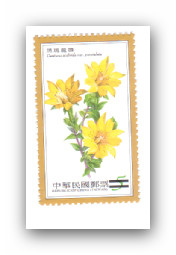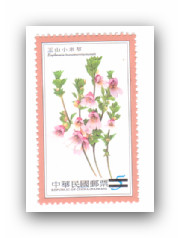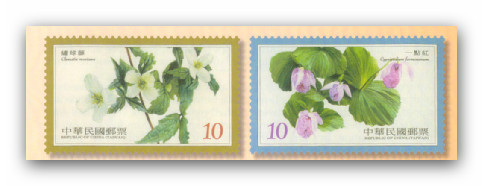Taiwan Alpine Flowers Stamps issued May 16, 2011
Taiwan is a mountainous island, with more than 200 mountains above 3,000 meters. With the wide range of vertical climatic zones on these mountains—from tropical and subtropical to temperate and cold—come some very diverse forests. Alpine plants grow in areas 3,000 meters above sea level. Constantly exposed to strong ultraviolet radiation, the blooms of these plants are brilliantly colorful. To introduce the beauty of Taiwan’s alpine flowers, Chunghwa Post is issuing a set of four stamps on these flowers.
- Gentiana scabrida var. punctulata (NT$5): The plant can be found in open meadows and gravelly slopes in high elevation areas of the Central Mountain Range. Each branch typically produces one or two (and occasionally three) terminal flowers. The blooms have yellow campanula calyx and corolla, with black spots at the base of the petals. Though small, when a colony of these colorful exquisite flowers is in full bloom, the sight is simply breathtaking.
- Euphrasia transmorrisonensis (NT$5): The plant
 can be found at high elevations. Its Chinese name literally means “millet grass,” either because its small seeds resemble millet or the two yellow marks on the flower’s lip resemble millet. Its flowers are arranged in racemes, with very short pedicels. Each of its tiny delicate white flowers has four tubular or campanula sepals and a smidgen of yellow on its corolla.
can be found at high elevations. Its Chinese name literally means “millet grass,” either because its small seeds resemble millet or the two yellow marks on the flower’s lip resemble millet. Its flowers are arranged in racemes, with very short pedicels. Each of its tiny delicate white flowers has four tubular or campanula sepals and a smidgen of yellow on its corolla.
- Clematis montana (NT$10): The plant can be found creeping in meadows or scrambling over shrubs on the sunny side of mountains at high elevations. The elegant white flower’s four large petal-like surfaces are actually its white sepals. The pale yellow filaments in the center of its blossoms are its stamen and pistil.
- .Cypripediumformosanum (NT$10): The plant can be found in moist forests on high elevation mountains. Its flowers are borne singly. The ovate lanceolate upper sepals of this showy flower are shell pink with pink veins. Bees enter through the opening of its bulging pouch-shaped labellum to carry out the task of pollination. In Chinese, the plant is nicknamed “umbrella” because its flower is shaped like one. And because its labellum resembles a slipper, the plant is also called Japanese lady’s slipper and Formosa lady’s slipper.
The Stamps were issued on May 16th of 2011. The stamps are printed in sheets of 16 in a 4 by 4 format on Phosphorescent stamp paper and printed by the Cardon Enterprises Co. The stamps have a perforation size of 12 with the individual stamps having a size of 30 X 50 mm for the low value stamps and 50 X 30 mm for the high value stamps
You must be logged in to post a comment.